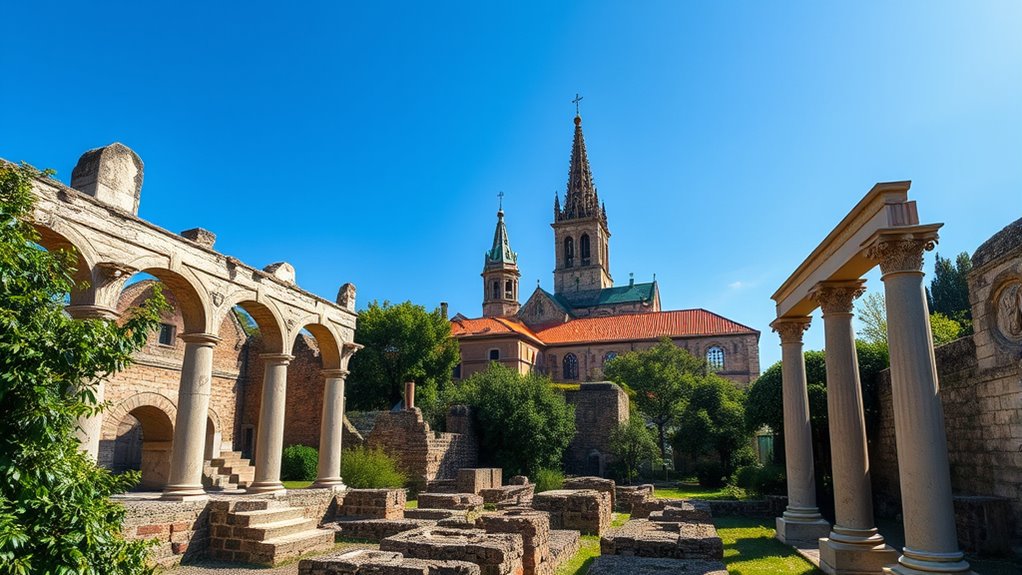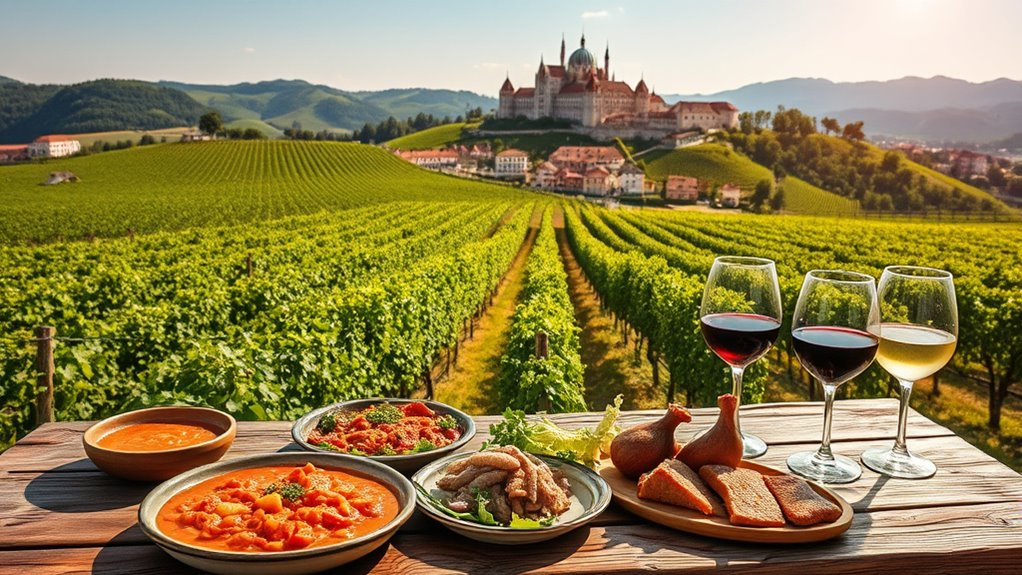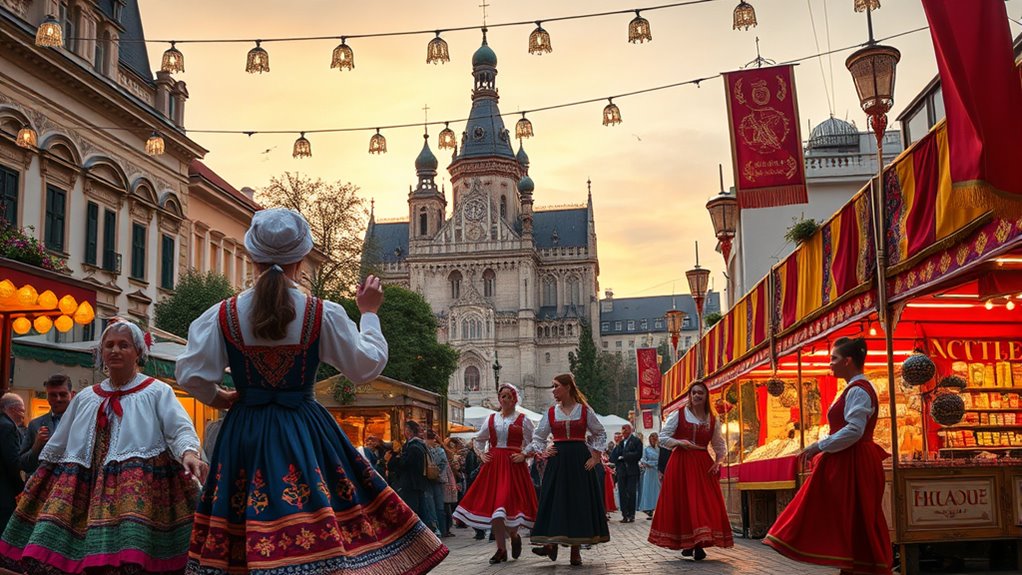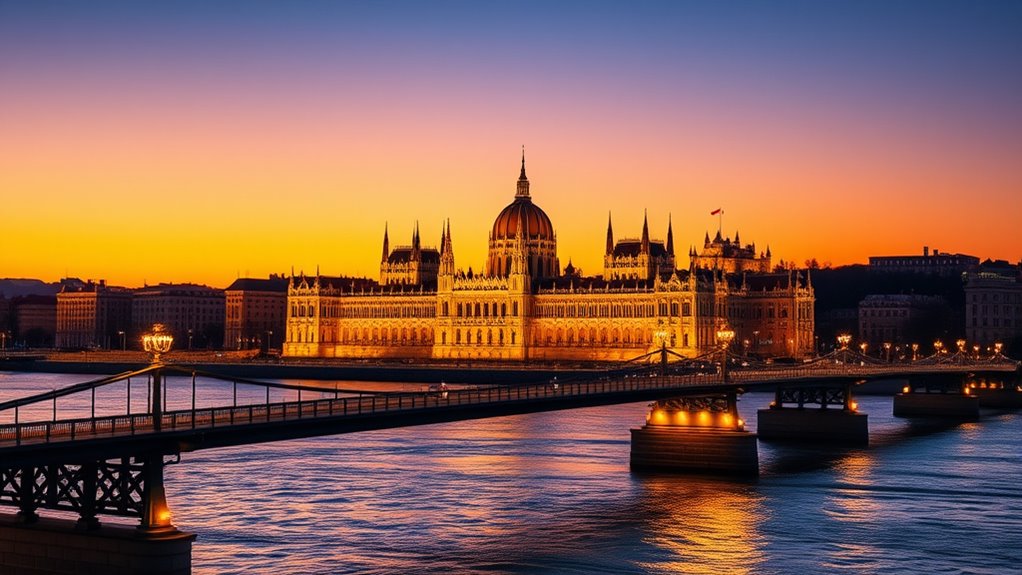Discover Hungary’s top attractions, from Budapest’s stunning Parliament Building, Matthias Church, and Chain Bridge to medieval towns like Hollókő and Sopron. Explore underground caves at Aggtelek, relax in the thermal waters of Gellért Baths, or visit UNESCO sites like Lake Fertő and Hortobágy National Park. Savor renowned wines from Tokaj and Villány, and enjoy vibrant festivals celebrating the country’s rich cultural traditions. Keep exploring to uncover even more of Hungary’s enthralling sights and experiences.
Key Takeaways
- Budapest’s historic landmarks include the Parliament Building, Matthias Church, Gellért Baths, Chain Bridge, and Castle Hill with the Royal Palace.
- Medieval towns like Hollókő and Sopron showcase UNESCO heritage sites and well-preserved architectural styles.
- UNESCO sites such as the Caves of Aggtelek, Lake Fertő, and Hortobágy National Park highlight Hungary’s natural and archaeological significance.
- Renowned wine regions like Tokaj, Villány, and Eger offer unique tasting experiences and rich winemaking traditions.
- Cultural festivals, including the Budapest Festival of Arts and Sziget Festival, celebrate Hungary’s vibrant arts, music, and heritage.
Budapest’s Historic Core and Danube Landmarks

Budapest’s historic core is a vibrant hub where centuries of history come alive along the Danube River. As you explore, you’ll see iconic sights like the Parliament Building, Hungary’s largest, with its striking Gothic Revival architecture. Nearby, Matthias Church stands out with its colorful roof tiles and stunning interior, while Gellért Baths invite you to relax in thermal waters. Strolling along the Danube’s banks, you’ll pass historical landmarks, including the Chain Bridge connecting Buda and Pest. Castle Hill offers panoramic views of the city and the Royal Palace, home to Hungary’s national art collections. Andrássy Avenue, a UNESCO site, guides you from the city center to Heroes’ Square, lined with elegant mansions, theaters, and the Opera House—a true showcase of Budapest’s rich heritage. Exploring the city’s historic sites can also reveal insights into its diverse architectural styles and cultural influences.
Medieval Towns and Their Rich Heritage

Medieval towns in Hungary offer a mesmerizing glimpse into the country’s rich heritage, with well-preserved architecture and centuries-old traditions. As you explore these towns, you’ll notice their charming cobblestone streets, historic buildings, and ancient fortifications. Hollókő stands out as a UNESCO site, showcasing traditional rural life from the 17th century. In Sopron, you’ll walk through a medieval town center filled with Roman, Gothic, and Baroque architecture, earning it the nickname “most faithful city.” Eger’s castle tells stories of resistance and offers panoramic views from its ramparts. Pannonhalma Archabbey, founded in 996, remains an active monastic community and a symbol of spiritual heritage. These towns invite you to step back in time and experience Hungary’s enduring medieval legacy firsthand. Additionally, exploring the heritage preservation efforts in these towns can provide insight into how their historical significance is maintained for future generations.
Natural Wonders and UNESCO Sites

Hungary’s natural landscapes and UNESCO sites showcase its unique beauty and rich history. From the extensive caves of Aggtelek to the UNESCO-listed Lake Fertő, these wonders invite you to explore their striking features. You’ll find that each site offers a glimpse into the country’s diverse ecological and cultural heritage. To ensure a memorable visit, it’s helpful to learn about the safety considerations and planning tips for exploring these attractions.
UNESCO World Heritage Sites
Hungary is home to several remarkable UNESCO World Heritage Sites that showcase its natural beauty and cultural history. These sites offer a glimpse into the country’s diverse landscapes and rich heritage. When exploring, you can enjoy:
- The Caves of Aggtelek Karst and Slovak Karst, an extensive underground cave system with stunning formations.
- Lake Fertő (Neusiedler See), a transboundary lake crucial for birdlife and steppe ecology.
- Hortobágy National Park, Hungary’s largest protected area, known for its Puszta landscape and traditional pastoral culture.
- The unique karst formations, which exemplify Hungary’s geological diversity and contribute to its UNESCO recognition.
These UNESCO sites highlight Hungary’s commitment to preserving natural wonders and historical significance, making them must-visit destinations for nature lovers and history enthusiasts alike.
Unique Natural Landscapes
Exploring Hungary’s natural landscapes reveals a stunning array of unique environments that captivate visitors. The Caves of Aggtelek Karst and Slovak Karst stand out as Hungary’s only natural UNESCO site, offering an extensive underground world of stalactites, stalagmites, and mysterious chambers. Lake Fertő, shared with Austria, is a crucial habitat for birdlife and features vast steppe landscapes, making it a UNESCO site worth exploring. Hortobágy National Park showcases Hungary’s traditional Puszta landscape, home to diverse flora and fauna, and is a UNESCO-listed protected area. Bükk National Park offers rugged karst terrain, caves, and rich biodiversity, perfect for outdoor adventures. Ultimately, the Tisza River supports abundant wildlife, especially during spring floods, adding to Hungary’s impressive natural diversity. Additionally, Hungary has been increasingly adopting sustainable energy practices, which contribute to the conservation of its natural environments.
Roman and Early Christian Heritage Sites

You can explore Budapest’s Roman history by visiting the extensive ruins of Aquincum, where mosaics and artifacts tell of its ancient past. Nearby, the Early Christian Necropolis of Pécs offers well-preserved frescoed tombs that reveal early Christian burial practices. These sites provide a fascinating glimpse into Hungary’s Roman and Christian heritage, connecting you to its long history. Additionally, many of these sites incorporate archaeological techniques that help uncover and preserve Hungary’s rich historical layers.
Roman Ruins in Budapest
Budapest’s Roman and early Christian heritage is vividly showcased through its well-preserved ruins and archaeological sites. As you explore, you’ll discover the rich history buried beneath the city’s modern streets. Highlights include:
- Aquincum Museum and Ruins: Wander through the remains of Budapest’s Roman capital, featuring mosaics, baths, and a well-preserved amphitheater.
- Roman Watchtower and Fortifications: Spot remnants of ancient defenses along the Danube, offering insight into Roman military strategy.
- Early Christian Burial Sites: View underground tombs and frescoed necropolises that reveal early Christian community life.
- Preservation of Ancient Sites: These archaeological remains are carefully conserved to offer visitors an authentic glimpse into Budapest’s ancient past.
These sites provide a fascinating glimpse into Budapest’s ancient past, blending history with engaging archaeological exhibits. Exploring them connects you to the city’s deep-rooted Roman and Christian heritage.
Early Christian Burial Sites
Beneath Budapest’s vibrant streets lie remarkable remnants of early Christian burial sites that showcase the city’s ancient religious history. You can explore ancient tombs, frescoed catacombs, and stone sarcophagi that reveal early Christian beliefs and practices. The Early Christian Necropolis in Pécs, a UNESCO site, features 4th-century frescoed tombs and mosaics, offering a glimpse into early Christian life. Nearby, the Roman ruins of Aquincum include burial sites with intricate mosaics and artifacts. These sites help you understand Hungary’s progression from paganism to Christianity, highlighting its spiritual evolution. The contrast ratio of the preserved mosaics and frescoes also enhances the visual storytelling of these historical sites.
Renowned Wine Regions and Culinary Delights

Hungary’s renowned wine regions offer a rich tapestry of flavors and historical significance that attract wine enthusiasts from around the world. You can explore legendary wineries and taste unique wines like the sweet nectars of Tokaj or the bold reds of Villány. These regions feature centuries-old cellars and picturesque vineyards that tell stories of Hungary’s winemaking heritage. To enhance your experience, consider:
- Sampling the famous Tokaj Aszú, a luscious dessert wine
- Visiting Eger’s historic cellars and tasting Bull’s Blood
- Enjoying modern wines at Villány’s boutique wineries
- Exploring winemaking traditions, which have been passed down through generations to preserve Hungary’s unique wine culture
Beyond wine, Hungarian cuisine delights with hearty dishes like goulash, paprika chicken, and chimney cake. Savor these flavors to fully immerse yourself in Hungary’s culinary culture, making your visit a memorable journey through taste and tradition.
Cultural Festivals and Unique Traditions

Experiencing Hungary’s cultural festivals offers a vibrant glimpse into its rich heritage and lively traditions. You’ll find festivals celebrating everything from art and music to historic customs. The Budapest Festival of Arts brings international performers to city venues, showcasing Hungary’s artistic significance. Sziget Festival, held on the Danube island, is one of Europe’s biggest music events, attracting diverse crowds. You can also witness Busójárás in Mohač, a UNESCO-listed carnival featuring masked dancers and lively parades that mark the end of winter. During Lavender Days at Pannonhalma Archabbey, you’ll stroll through fragrant gardens and enjoy local events in a historic setting. These festivals allow you to immerse yourself in Hungary’s cultural soul, blending tradition, history, and modern celebration seamlessly. Additionally, traditional crafts are often showcased during these celebrations, highlighting Hungary’s dedication to preserving its artisanal heritage.
Frequently Asked Questions
What Are the Best Viewpoints on Castle Hill for Panoramic City Views?
You should head to the Fisherman’s Bastion for stunning panoramic views of Budapest, especially over the Danube and Parliament Building. Buda Castle also offers fantastic vistas from its terraces, giving you a majestic perspective of the city’s rooftops and bridges. Don’t miss the Citadella on Gellért Hill, which provides sweeping, elevated views of the entire cityscape. These spots let you appreciate Budapest’s beauty from the best viewpoints on Castle Hill.
Which Medieval Site Offers the Most Authentic Hungarian Rural Experience?
You’ll find Hollókő offers the most authentic Hungarian rural experience, and it’s a UNESCO World Heritage site. This preserved 17th-century village, with traditional houses and local customs, reflects rural life for over 400 years. As you walk its cobblestone streets, you’ll see farmers in traditional dress and centuries-old farming practices still alive, giving you a genuine taste of Hungary’s rural heritage. It’s a living museum of Hungary’s pastoral traditions.
How Extensive Is the Cave System in Aggtelek National Park?
You’ll find the cave system in Aggtelek National Park incredibly extensive, spanning over 100 kilometers of underground passages. As you explore, you’ll encounter impressive stalactites, stalagmites, and underground chambers. The caves are well-preserved and accessible for guided tours, giving you a unique glimpse into Hungary’s natural underground beauty. This UNESCO World Heritage site offers a fascinating adventure through one of Europe’s most expansive and enthralling cave networks.
Where Can I Learn About Hungary’s Roman History Beyond Budapest?
Imagine unearthing a hidden chapter of Hungary’s past; you can explore beyond Budapest at Szombathely, where Roman ruins whisper stories of Savaria’s ancient glory, or wander through Gorsium-Herculia’s archaeological site, revealing Roman town remnants. These sites serve as living pages of history, letting you walk through time and touch the footprints of emperors and soldiers, deepening your understanding of Hungary’s rich Roman heritage far from the city’s bustling streets.
Which Wine Region Produces the Most Renowned Sweet Wines?
You should visit the Tokaj Wine Region if you’re after Hungary’s most renowned sweet wines. This UNESCO World Heritage site is famous for its legendary “nectar” wines, made from grapes affected by noble rot, which concentrate their sugars and flavors. You can explore historic vineyards, taste authentic Tokaji Aszú, and learn about the region’s centuries-old winemaking traditions, making it a must-see for wine lovers seeking exceptional sweet wines.
Conclusion
Hungary’s attractions truly offer something for everyone. Did you know Budapest’s Parliament building is one of Europe’s most photographed landmarks? From historic castles to vibrant festivals, you’ll find unforgettable experiences around every corner. Whether exploring medieval towns or tasting world-class wines, you’ll leave with lasting memories. So, immerse yourself in Hungary’s rich culture and natural beauty—you’re sure to discover your new favorite spot in this enthralling country.






